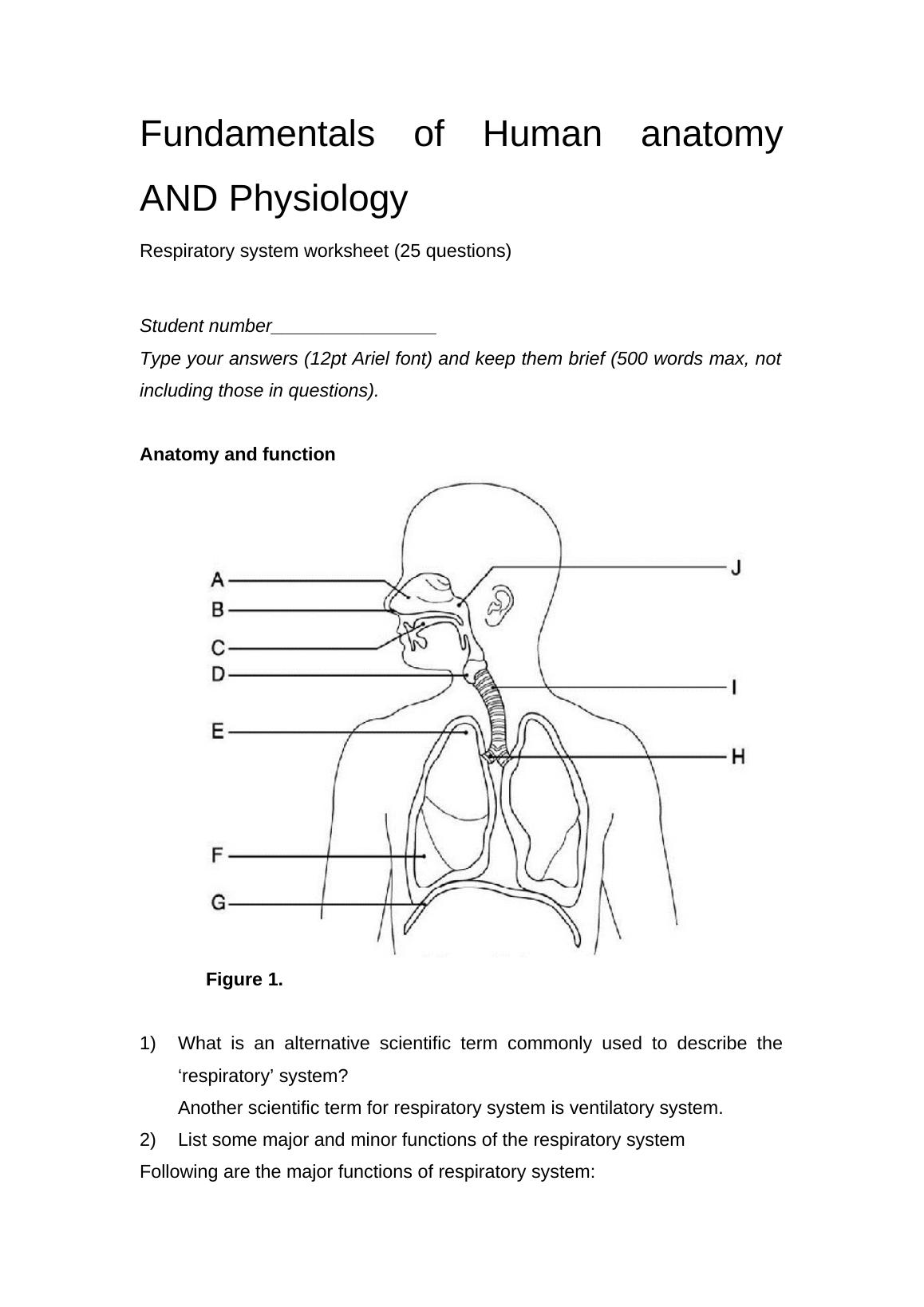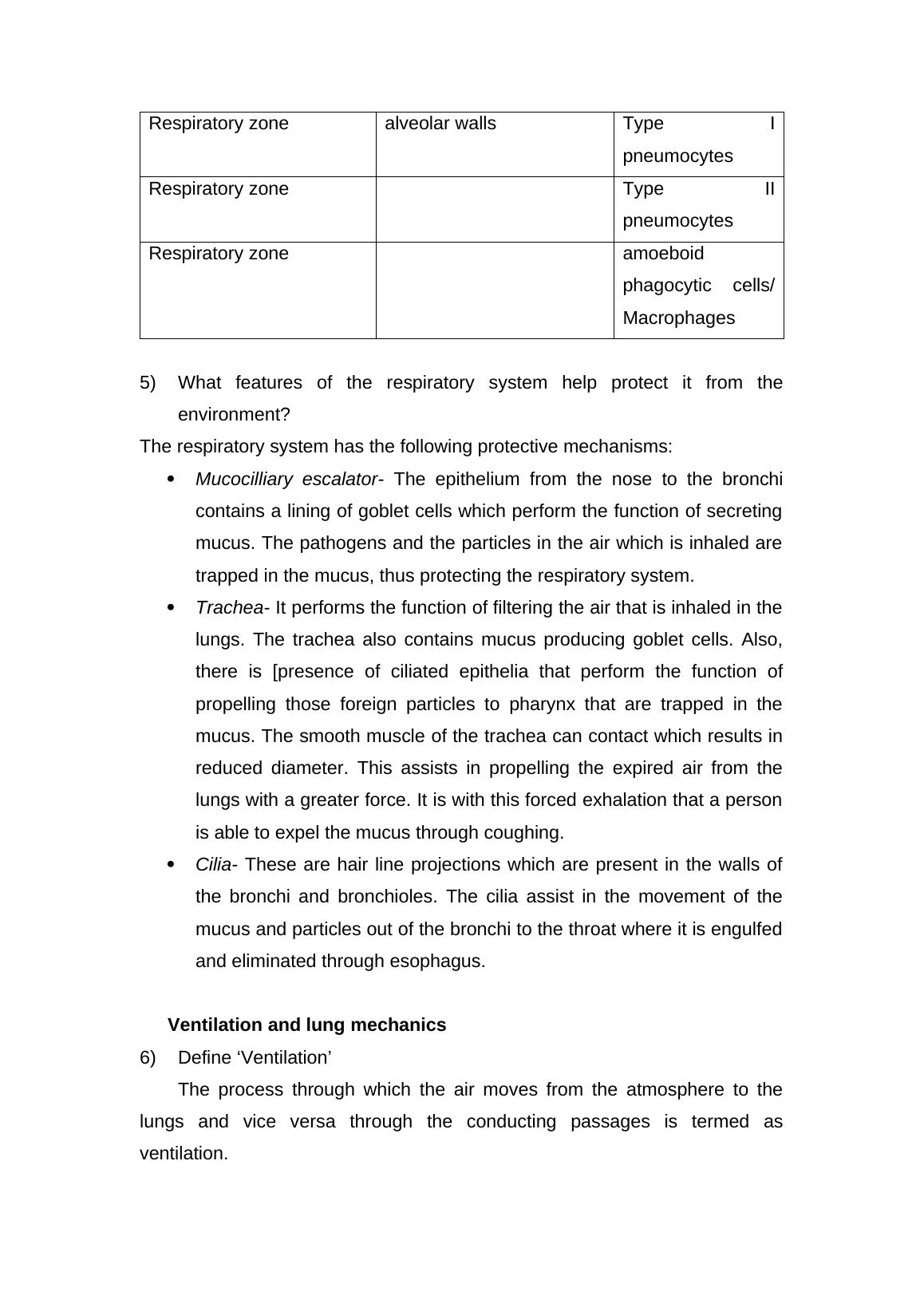Fundamentals of Human Anatomy and Physiology: Respiratory System Worksheet
Added on 2022-12-22
8 Pages2117 Words4 Views
Fundamentals of Human anatomy
AND Physiology
Respiratory system worksheet (25 questions)
Student number________________
Type your answers (12pt Ariel font) and keep them brief (500 words max, not
including those in questions).
Anatomy and function
Figure 1.
1) What is an alternative scientific term commonly used to describe the
‘respiratory’ system?
Another scientific term for respiratory system is ventilatory system.
2) List some major and minor functions of the respiratory system
Following are the major functions of respiratory system:
AND Physiology
Respiratory system worksheet (25 questions)
Student number________________
Type your answers (12pt Ariel font) and keep them brief (500 words max, not
including those in questions).
Anatomy and function
Figure 1.
1) What is an alternative scientific term commonly used to describe the
‘respiratory’ system?
Another scientific term for respiratory system is ventilatory system.
2) List some major and minor functions of the respiratory system
Following are the major functions of respiratory system:

Gas exchange- There is exchange of oxygen and carbon dioxide
Protection- It protects the body from dust and microbes through the
mechanism of coughing, mucus production and cilia
Following are the minor functions of the respiratory system:
Sound production
It also provides olfactory assistance or sense of smell.
3) List the structures Labelled A-J in the diagram above (figure 1).
Following is the list of the structures labelled in the diagram:
A- Nasal cavity
B- Nostril
C- Oral Cavity
D- Larynx
E- Right Lung
F- Lower lobe
G- Diaphragm
H- Left main bronchus
I- Trachea
J- Pharynx
4) List the structures/tissues/cells of the respiratory system and assign them
to each zone (expand table if needed)
Zone Tissues Cells
Conducting Zone Ciliated columnar
epithelium
Goblet cells
Conducting Zone
Conducting Zone Pseudostratified columnar
epithelium
goblet cells
Conducting Zone Simple cuboidal
epithelium
olfactory mucosa sensory receptor
cells
Respiratory zone bronchiolar epithelium club cells
Protection- It protects the body from dust and microbes through the
mechanism of coughing, mucus production and cilia
Following are the minor functions of the respiratory system:
Sound production
It also provides olfactory assistance or sense of smell.
3) List the structures Labelled A-J in the diagram above (figure 1).
Following is the list of the structures labelled in the diagram:
A- Nasal cavity
B- Nostril
C- Oral Cavity
D- Larynx
E- Right Lung
F- Lower lobe
G- Diaphragm
H- Left main bronchus
I- Trachea
J- Pharynx
4) List the structures/tissues/cells of the respiratory system and assign them
to each zone (expand table if needed)
Zone Tissues Cells
Conducting Zone Ciliated columnar
epithelium
Goblet cells
Conducting Zone
Conducting Zone Pseudostratified columnar
epithelium
goblet cells
Conducting Zone Simple cuboidal
epithelium
olfactory mucosa sensory receptor
cells
Respiratory zone bronchiolar epithelium club cells

Respiratory zone alveolar walls Type I
pneumocytes
Respiratory zone Type II
pneumocytes
Respiratory zone amoeboid
phagocytic cells/
Macrophages
5) What features of the respiratory system help protect it from the
environment?
The respiratory system has the following protective mechanisms:
Mucocilliary escalator- The epithelium from the nose to the bronchi
contains a lining of goblet cells which perform the function of secreting
mucus. The pathogens and the particles in the air which is inhaled are
trapped in the mucus, thus protecting the respiratory system.
Trachea- It performs the function of filtering the air that is inhaled in the
lungs. The trachea also contains mucus producing goblet cells. Also,
there is [presence of ciliated epithelia that perform the function of
propelling those foreign particles to pharynx that are trapped in the
mucus. The smooth muscle of the trachea can contact which results in
reduced diameter. This assists in propelling the expired air from the
lungs with a greater force. It is with this forced exhalation that a person
is able to expel the mucus through coughing.
Cilia- These are hair line projections which are present in the walls of
the bronchi and bronchioles. The cilia assist in the movement of the
mucus and particles out of the bronchi to the throat where it is engulfed
and eliminated through esophagus.
Ventilation and lung mechanics
6) Define ‘Ventilation’
The process through which the air moves from the atmosphere to the
lungs and vice versa through the conducting passages is termed as
ventilation.
pneumocytes
Respiratory zone Type II
pneumocytes
Respiratory zone amoeboid
phagocytic cells/
Macrophages
5) What features of the respiratory system help protect it from the
environment?
The respiratory system has the following protective mechanisms:
Mucocilliary escalator- The epithelium from the nose to the bronchi
contains a lining of goblet cells which perform the function of secreting
mucus. The pathogens and the particles in the air which is inhaled are
trapped in the mucus, thus protecting the respiratory system.
Trachea- It performs the function of filtering the air that is inhaled in the
lungs. The trachea also contains mucus producing goblet cells. Also,
there is [presence of ciliated epithelia that perform the function of
propelling those foreign particles to pharynx that are trapped in the
mucus. The smooth muscle of the trachea can contact which results in
reduced diameter. This assists in propelling the expired air from the
lungs with a greater force. It is with this forced exhalation that a person
is able to expel the mucus through coughing.
Cilia- These are hair line projections which are present in the walls of
the bronchi and bronchioles. The cilia assist in the movement of the
mucus and particles out of the bronchi to the throat where it is engulfed
and eliminated through esophagus.
Ventilation and lung mechanics
6) Define ‘Ventilation’
The process through which the air moves from the atmosphere to the
lungs and vice versa through the conducting passages is termed as
ventilation.

End of preview
Want to access all the pages? Upload your documents or become a member.
Related Documents
Introduction to Human Anatomylg...
|11
|1644
|358
Human Respiratory and Cardiac Systemslg...
|26
|3751
|23
Managing Care of the Adult Patient Assignmentlg...
|14
|4307
|133
Structure of Tissues | Anatomy and Physiologylg...
|6
|1487
|70
Respiratory Systemlg...
|16
|2909
|483
Role of Respiratory Systemlg...
|15
|1097
|17
